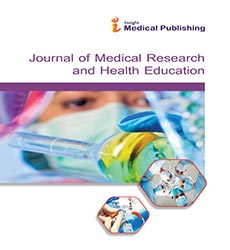Strategies for Effective Public Health Education in Low-Resource Settings
Afiqah Lee*
Department of Medicine, University of Salerno, 84081 Baronissi, Italy
*Corresponding author:
Afiqah Lee,
Department of Medicine, University of Salerno, 84081 Baronissi, Italy,
E-mail: Lee.afiq@unisa.it
Received date: February 03, 2025, Manuscript No. ipjmrhe-25-20727; Editor assigned date: February 05, 2025, PreQC No. ipjmrhe-25-20727 (PQ); Reviewed date: February 10, 25, QC No. ipjmrhe-25-20727; Revised date: February 17, 2025, Manuscript No. ipjmrhe-25-20727 (R); Published date: February 24, 2025, DOI: 10.36648/2393-8862.9.1.01
Citation: Lee A (2025) Strategies for Effective Public Health Education in Low-Resource Settings. J Med Res Health Educ Vol. 9 No.1:01
Introduction
Public health education plays a critical role in improving health outcomes, preventing disease and promoting well-being, particularly in low-resource settings where access to healthcare is limited. These environments often face challenges such as poverty, low literacy rates, inadequate healthcare infrastructure and limited access to clean water and sanitation. Infectious diseases, malnutrition, maternal and child health issues and preventable chronic diseases disproportionately affect these populations. Effective public health education empowers communities to adopt healthy behaviors, make informed decisions and utilize available health services, ultimately reducing morbidity and mortality. Designing and implementing impactful education strategies in low-resource settings requires a nuanced understanding of social, cultural, economic and environmental factors, as well as innovative approaches to overcome barriers to information dissemination and behavior change [1].
Description
One of the foundational strategies in public health education understands the target population, including their beliefs, attitudes, literacy levels and social dynamics. Conducting needs assessments and community surveys helps identify prevalent health issues, knowledge gaps and barriers to behavior change. Participatory approaches, where community members are actively involved in planning and implementing education programs enhance relevance, acceptability and sustainability. Engaging local leaders, community health workers and peer educators fosters trust and encourages adoption of health-promoting behaviors. Tailoring educational content to the local context, using familiar examples and culturally sensitive messaging, increases comprehension and engagement, particularly in populations with limited literacy [2].
Utilizing diverse communication channels is essential for maximizing reach and effectiveness. Visual aids, pictograms, storytelling and drama-based interventions can convey health messages to audiences with low literacy. Radio programs, community loudspeakers and mobile phone messaging (SMS or voice calls) are effective tools for disseminating information in areas with limited internet access. Community workshops, health fairs and interactive demonstrations provide hands-on learning opportunities and reinforce behavior change. Collaboration with schools, religious institutions and local organizations ensures broader outreach and continuity of education efforts [1].
Training and deploying Community Health Workers (CHWs) is a highly effective strategy in low-resource settings. CHWs serve as liaisons between formal healthcare systems and the community, providing education, screening, counseling and referrals. Their shared cultural and linguistic background with the community enhances communication, trust and adherence to health recommendations. CHWs can deliver education on a wide range of topics, including maternal and child health, nutrition, vaccination, hygiene, chronic disease prevention and infectious disease control. Capacity-building programs for CHWs, including training in communication, health literacy and behavior change techniques, ensure consistent and accurate messaging.
Incorporating behavior change theories into public health education improves the likelihood of sustained impact. Frameworks such as the Health Belief Model, Theory of Planned Behavior and Social Cognitive Theory guide the design of interventions by addressing perceived susceptibility, benefits, barriers and self-efficacy and social norms. For instance, emphasizing the immediate benefits of handwashing or vaccination, addressing misconceptions and demonstrating practical techniques increases compliance. Peer-led interventions, role modeling and community champions create social reinforcement, making healthy behaviors more socially acceptable and easier to adopt [2]. Leveraging technology, even in low-resource contexts, has emerged as a powerful tool for public health education. Mobile Health (mHealth) applications, SMS campaigns and interactive voice response systems can provide reminders, health tips and alerts for vaccination or disease outbreaks.
Community radio programs and locally produced video content can disseminate health messages widely, overcoming geographical and infrastructural barriers. Innovative approaches such as gamification, interactive quizzes and social media engagement (where accessible) can increase participation, motivation and retention of health knowledge.
Conclusion
Effective public health education in low-resource settings is a multifaceted endeavor that requires cultural sensitivity, community engagement, innovative communication strategies and integration with broader health initiatives. Understanding local contexts, leveraging trusted community networks and employing diverse media including visual aids, radio, mobile technology and interactive methods maximize reach and impact. Training and empowering community health workers, applying behavior change theories and fostering partnerships enhance program effectiveness and sustainability. Monitoring, evaluation and adaptation based on evidence and community feedback ensure continuous improvement and relevance. Addressing equity, inclusivity and the needs of vulnerable populations strengthens the overall impact of education programs.
By implementing these evidence-based strategies, public health practitioners can empower communities, improve health literacy, reduce disease burden and promote lasting behavioral change, ultimately contributing to healthier, more resilient populations in low-resource settings.Acknowledgement
None.
Conflict of Interest
None.
References
- Jiang Y, Hatzi K, Shaknovich R (2013) Mechanisms of epigenetic deregulation in lymphoid neoplasms. Blood 121: 4271-4279.
Google Scholar Cross Ref Indexed at
- Geutjes EJ, Bajpe PK, Bernards R (2012) Targeting the epigenome for treatment of cancer. Oncogene 31: 3827-3844.
Open Access Journals
- Aquaculture & Veterinary Science
- Chemistry & Chemical Sciences
- Clinical Sciences
- Engineering
- General Science
- Genetics & Molecular Biology
- Health Care & Nursing
- Immunology & Microbiology
- Materials Science
- Mathematics & Physics
- Medical Sciences
- Neurology & Psychiatry
- Oncology & Cancer Science
- Pharmaceutical Sciences
